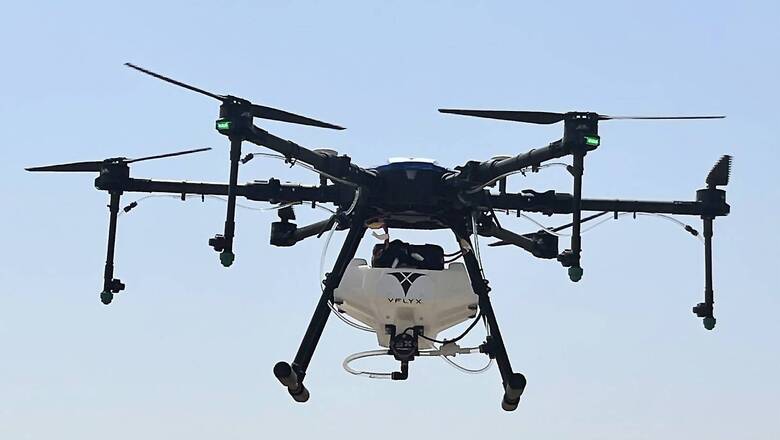
views
When it comes to technical advancement, the scenario is not the same as 10 years ago. Unmanned aircraft systems (UAS), commonly known as “drones”, have gained widespread acceptance in a variety of industries. India, slowly but steadily, is understanding the usage of this technology. Meanwhile, the government is supporting the technology under the Aatmanirbhar Bharat agenda.
Additionally, the Centre has also taken several initiatives to promote the use of drone technology in India, including the SVAMITVA (Survey of Villages Abadi & Mapping with Improvised Technology in Village Areas) scheme, liberalisation in drone rules, approval of the production-linked incentive (PLI) scheme for drones and drone components, Hara Bhara campaign, Gwalior Drone Mela and Kisan Drone Yatra.
News18 spoke to Vishal Saurav, CEO & Founder of VFLYX India, a drone technology company based in Bengaluru planning to invest around 3.4 million dollars in R&D, manufacturing, and testing of drones. As an industry insider, he gave an informed view of this growing industry in India against the backdrop of the government’s initiatives. Here’s what he had to say on a range of related issues.
Drone tech buzz
“The drone tech industry is currently generating buzz all around India as the government is actively promoting the same. Although I must say that technology-wise, we are not yet at par with the latest advancements and global benchmark. There are many areas where there is a scope for improvement. In the next few years, I can see a boom in this industry as different sectors like agriculture, healthcare, and logistics are actively adopting the technology and applying it in their day-to-day operations. The support from the government is also a big boost. We are expecting the drone market to grow tenfold in the next five years with the Indian drones flying not only in India but in many other countries, especially Southeast Asian countries and African regions.”
Role in agriculture
“Agriculture is one of the sectors that is adopting drone technology rapidly and there is a huge niche market that is yet to be tapped. Very few people related to agriculture currently know about the utilisation of drone technology. Drones can be used to do many things like sowing crops, spreading fertilisers and pesticides, soil/crop analysis, surveillance, etc. If utilised optimally, drones can boost the Indian agro industry and take it to the next level. In the agriculture sector, our farmers are facing a lot of challenges that can be solved using drone technology. Agriculture is one of the major industries in India and its potential to become even bigger with the help of technology implementation will help in increasing and improvising the quality of yield, thus benefiting the farmers and increasing its contribution to the country’s GDP.”
Other industries that could benefit
“Sectors like healthcare, logistics (especially hyperlocal delivery of small/lightweight packages), surveillance, defence, construction and real estate, smart city development, etc, aren’t far behind. In fact, we have already witnessed exemplary cases where drone services were piloted, be it transporting organs for emergency transplantation, food delivery by start-ups, etc. Drones are already in active use in the defence and scientific research sectors and are slowly making their way into the other industries. Drone technology tends to benefit and revolutionise the way the industries are working, especially in their day-to-day operations and relevant data collection. Due to the inherent power of drones for flying and capturing aerial data, their application potential is enormous for most industries in some way or the other. Drones are giving accurate data which can help in taking the right decisions, save time and money compared to a manual task done, and, in many cases, provide safety by going to some life-threatening places and situations. It is true that the drone industry in India is still in its nascent stage, and we do have a long road ahead. However, with the much-needed push from the government through its initiatives and schemes, and the burgeoning drone-tech start-ups, we are confident to reach there soon.”
PLI scheme
“This (the PLI scheme) is definitely a very good initiative by the government as every industry needs some push which will eventually make the industry prosper. After the introduction of the PLI scheme, the production of drones will be much higher. Initially, the cost may be a bit high but as the demand increases, gradually the cost will decrease. With more and more technology companies taking an interest, the research and development of new-age tech drones will not be very far away. Whenever we reach that level, we will be able to export drones all over the world and India will gradually become a global drone manufacturing hub. However, to enable India to be a leader in the drone tech industry, the PLI scheme is not enough. We would need a bigger push and aid from the government, especially towards the manufacturing and R&D efforts. We also need to introduce drone tech to the coming generation in their curriculum so that we have them ready for the coming wave of drones in India.”
Regulation standards
“Until recently, the Indian drone tech industry was combating massive regulatory shackles as regulation standards were pretty stringent. When compared to global standards and regulations, we had a very restrictive mechanism with limitations in flying capabilities, complexities in licensing efforts, ambiguity in policies and schemes, etc. However, many of these handicaps were addressed in the latest Union Budget where some of the restrictions were completely done away with while the others were eased to make operations easier for drone tech players and promote drone adoption in the nation. This has come as a relief for drone players like us, but we strongly feel that these policies and schemes need to be revised from time to time to keep pace with the global standards and continue being beneficial for companies and start-ups.”
Requirement of R&D
“I think research and development are the backbones of the drone industry. Currently, we are lacking the cutting-edge technology in this sector and because of that, we can’t make state-of-the-art drones that can be used in the defence sector or can be exported globally. Extensive research and development are the need of the hour. If we prioritise R&D, I am positive that within a year we will be able to make drones that can compete globally and be self-reliant when it comes to our defence sector.”
Farming depletion and use of drones
“Farming depletion can occur due to different reasons like overuse of pesticides, inappropriate sowing, and inadequate or excessive use of fertilisers. Drones can help overcome these problems by evenly distributing seeds, and spraying appropriate amounts of fertilisers so as to minimise the errors that occur if the tasks are done manually. Basically, drones are automating some important work that otherwise can cause problems due to human errors, which in turn may lead to soil depletion. Apart from this, drones can also be immensely beneficial in mapping the soil and crops to check the quality of both and make informed decisions and evade heavy losses from crop failure or low-quality crops. Drones spraying ensure that there is far less pesticide being used compared to manual spraying and spraying can be done only for the plants that actually need it. At VFLYX we tend to spread awareness about the benefits of agri- drones in India’s farming community by conducting live demonstrations at the root level. Also, we are joining hands with the farmers’ associations and agri- products companies to increase our reach.”
VFLYX’s contribution
“VFLYX’s major investments have been in creating the drone manufacturing facility and in attracting the right talent to execute the manufacturing and testing process without compromising on quality and technology. This has helped the company come up with the three series of drones that are game changers for the application of survey, surveillance, and agriculture. At VFLYX we tend to contribute to building a healthy drone community where learning and implementation happen side by side. With drones being a new technology for most people in India, a lot of awareness and demo programmes will be conducted to help industries understand how drones work and the benefits they can avail of. We have implemented drone as a service (DaaS), where we give drones and pilots for rent for a certain time period or for certain projects. Through this, companies can do pilot projects or outsource their drone usage and output processing, thus reducing their initial investment, and avoiding hassles in drone operation and post-processing the data. Therefore, awareness and ease of drone technology access at an economical cost will be helpful in increasing drone adoption in India.”
Read all the Latest Tech News here



















Comments
0 comment